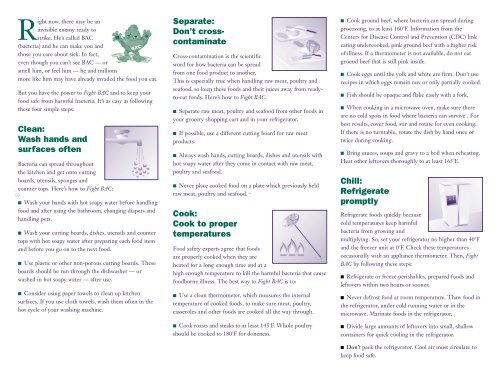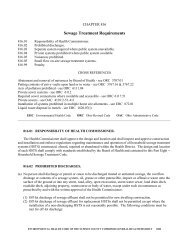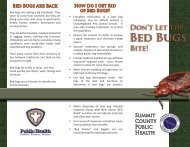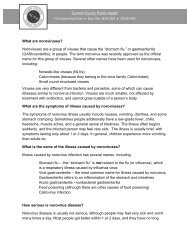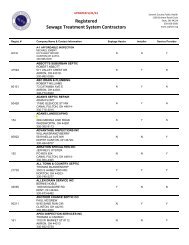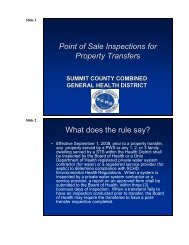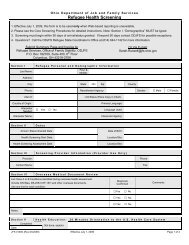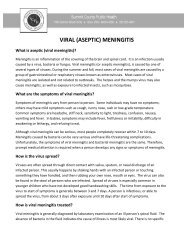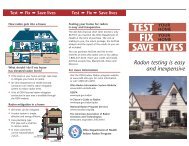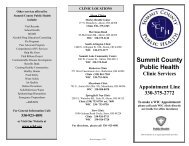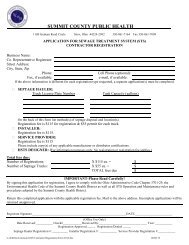Fight BAC⢠- Four Simple Steps to Food Safety Brochure
Fight BAC⢠- Four Simple Steps to Food Safety Brochure
Fight BAC⢠- Four Simple Steps to Food Safety Brochure
You also want an ePaper? Increase the reach of your titles
YUMPU automatically turns print PDFs into web optimized ePapers that Google loves.
Right now, there may be an<br />
invisible enemy ready <strong>to</strong><br />
strike. He’s called BAC<br />
(bacteria) and he can make you and<br />
those you care about sick. In fact,<br />
even though you can’t see BAC — or<br />
smell him, or feel him — he and millions<br />
more like him may have already invaded the food you eat.<br />
But you have the power <strong>to</strong> <strong>Fight</strong> BAC and <strong>to</strong> keep your<br />
food safe from harmful bacteria. It’s as easy as following<br />
these four simple steps:<br />
Clean:<br />
Wash hands and<br />
surfaces often<br />
Bacteria can spread throughout<br />
the kitchen and get on<strong>to</strong> cutting<br />
boards, utensils, sponges and<br />
counter <strong>to</strong>ps. Here’s how <strong>to</strong> <strong>Fight</strong> BAC:<br />
18<br />
■ Wash your hands with hot soapy water before handling<br />
food and after using the bathroom, changing diapers and<br />
handling pets.<br />
■ Wash your cutting boards, dishes, utensils and counter<br />
<strong>to</strong>ps with hot soapy water after preparing each food item<br />
and before you go on <strong>to</strong> the next food.<br />
■ Use plastic or other non-porous cutting boards. These<br />
boards should be run through the dishwasher — or<br />
washed in hot soapy water — after use.<br />
■ Consider using paper <strong>to</strong>wels <strong>to</strong> clean up kitchen<br />
surfaces. If you use cloth <strong>to</strong>wels, wash them often in the<br />
hot cycle of your washing machine.<br />
Separate:<br />
Don’t crosscontaminate<br />
Cross-contamination is the scientific<br />
word for how bacteria can be spread<br />
from one food product <strong>to</strong> another.<br />
This is especially true when handling raw meat, poultry and<br />
seafood, so keep these foods and their juices away from ready<strong>to</strong>-eat<br />
foods. Here’s how <strong>to</strong> <strong>Fight</strong> BAC:<br />
■ Separate raw meat, poultry and seafood from other foods in<br />
your grocery shopping cart and in your refrigera<strong>to</strong>r.<br />
■ If possible, use a different cutting board for raw meat<br />
products.<br />
■ Always wash hands, cutting boards, dishes and utensils with<br />
hot soapy water after they come in contact with raw meat,<br />
poultry and seafood.<br />
■ Never place cooked food on a plate which previously held<br />
raw meat, poultry and seafood.<br />
Cook:<br />
Cook <strong>to</strong> proper<br />
temperatures<br />
<strong>Food</strong> safety experts agree that foods<br />
are properly cooked when they are<br />
heated for a long enough time and at a<br />
high enough temperature <strong>to</strong> kill the harmful bacteria that cause<br />
foodborne illness. The best way <strong>to</strong> <strong>Fight</strong> BAC is <strong>to</strong>:<br />
■ Use a clean thermometer, which measures the internal<br />
temperature of cooked foods, <strong>to</strong> make sure meat, poultry,<br />
casseroles and other foods are cooked all the way through.<br />
TM<br />
■ Cook ground beef, where bacteria can spread during<br />
processing, <strong>to</strong> at least 160 o F. Information from the<br />
Centers for Disease Control and Prevention (CDC) link<br />
eating undercooked, pink ground beef with a higher risk<br />
of illness. If a thermometer is not available, do not eat<br />
ground beef that is still pink inside.<br />
■ Cook eggs until the yolk and white are firm. Don’t use<br />
recipes in which eggs remain raw or only partially cooked.<br />
■ Fish should be opaque and flake easily with a fork.<br />
■ When cooking in a microwave oven, make sure there<br />
are no cold spots in food where bacteria can survive . For<br />
best results, cover food, stir and rotate for even cooking.<br />
If there is no turntable, rotate the dish by hand once or<br />
twice during cooking.<br />
■ Bring sauces, soups and gravy <strong>to</strong> a boil when reheating.<br />
Heat other lef<strong>to</strong>vers thoroughly <strong>to</strong> at least 165 o F.<br />
Chill:<br />
Refrigerate<br />
promptly<br />
Refrigerate foods quickly because<br />
cold temperatures keep harmful<br />
bacteria from growing and<br />
multiplying. So, set your refrigera<strong>to</strong>r no higher than 40 o F<br />
and the freezer unit at 0 o F. Check these temperatures<br />
occasionally with an appliance thermometer. Then, <strong>Fight</strong><br />
BAC by following these steps:<br />
■ Refrigerate or freeze perishables, prepared foods and<br />
lef<strong>to</strong>vers within two hours or sooner.<br />
■ Never defrost food at room temperature. Thaw food in<br />
the refrigera<strong>to</strong>r, under cold running water or in the<br />
microwave. Marinate foods in the refrigera<strong>to</strong>r.<br />
■ Cook roasts and steaks <strong>to</strong> at least 145 o F. Whole poultry<br />
should be cooked <strong>to</strong> 180 o F for doneness.<br />
■ Divide large amounts of lef<strong>to</strong>vers in<strong>to</strong> small, shallow<br />
containers for quick cooling in the refrigera<strong>to</strong>r.<br />
■ Don’t pack the refrigera<strong>to</strong>r. Cool air must circulate <strong>to</strong><br />
keep food safe.


